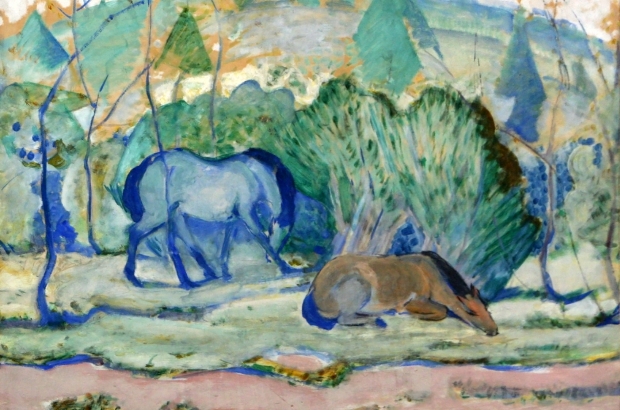- Daily & Weekly newsletters
- Buy & download The Bulletin
- Comment on our articles
Hitler’s “degenerate art” on view in Liège
In the wake of recent events in Europe, an exhibition in Liège on the theme of art as a tool of resistance and propaganda takes on particular significance. Degenerate Art According to Hitler: The Lucerne Auction at La Cité Miroir features, for the first time, modern artworks from the 1939 Galerie Fischer Auction in Lucerne, Switzerland.
Tracing the paintings and sculptures put up for sale by the Nazi regime proved to be a difficult task, requiring considerable detective work and patience on the part of the show’s curator Jean-Patrick Duschesne. In the end, Duschesne managed to bring together some exceptional pieces, including works by Ernst Barlach, Marc Chagall, Otto Dix, James Ensor, Paul Gauguin, Oscar Kokoschka, Max Liebermann, Emil Nolde and Pablo Picasso.
A failed artist and self-proclaimed art critic, Hitler condemned modern art in all its forms (Constructivism, Dadaism, Expressionism, etc) as degenerate because it displayed qualities, he argued, of mental illness, weakness of character, racial impurity and decay.
Germany’s political and cultural renewal required its society to be purged of all Bolsheviks, Jews and other alien influences. Museum officials were dismissed, artists were banned from the Academy of Fine Arts, the Bauhaus School was shut down, exhibitions were forbidden and works of modern art were confiscated from all German state museums and public spaces.
Authentic atmosphere
Set designer Christophe Gaeta has created an exhibition space and atmosphere at Cité Miroir that not only explains the historical context of the notorious Lucerne Auction but also enables visitors to experience it. Each piece is presented with its original inventory number and starting price, on what appears to be a ‘ripped out’ piece of wall and flooring.
Surrounded by a sea of darkness, these islands of art dramatically convey the notion of duress and confiscation. The sounds of the auction recreated in the background add to the dramatic effect.
As I walk through the exhibition, I am baffled. How could a painting so innocent and beautiful as Nolde’s “Blumengarten X” (1926) or Franz Marc’s “Chevaux au Pâturage” (1910, pictured above) have been considered degenerate and threatening to German values?
While there were no written guidelines for branding art as degenerate, Nazi ideology condemned avant-garde art as being too individualistic and subjective for collective thinking. Accordingly, images conveying human emotion or suffering were considered offensive.
German 'essence'
Culture in the Third Reich was to promote the German ‘essence’ – Nordic beauty, motherhood, family, work and the homeland. The idealisation of primitive or indigenous ‘sub-cultures’ was unpatriotic and degrading. Moreover, art was to be clear and comprehensible to the common volk. Garish colours, simplified forms, bold outlines or a distorted scale in avant-garde art were aberrant.
No modern artists were spared, not even those, such as Nolde, who were card-carrying members of the National Socialist party.
Initially, confiscated works were used for propaganda purposes, most notably the Entartete Kunst shame exhibitions. While many were later destroyed, Berlin art dealer Karl Haberstock convinced Hitler to sell the most valuable works on the international market as a means of raising much-needed funds for the Third Reich. Four art dealers, among them the Hildebrand Gurlitt, were commissioned to sell the degenerate works.
Galerie Fischer put 125 of the most valuable and rare pieces up for auction in Switzerland in June of 1939. While many important figures from the art world boycotted the auction, some 350 did attend, including collectors (Joseph Pulitzer Junior, Joseph van Sternberg, Pierre Matisse), dealers (Curt Valentin, Karl Nierendorf, Theodor Wolfer) and museum officials from Belgium, The Netherlands and Switzerland.
Disappointing return for Third Reich
Among the most sought after lots was Van Gogh’s “Self-Portrait Dedicated to Paul Gauguin” (1888), confiscated from the Neue Staaatsgalerie. Maurice Werthheim, an investment banker in New York, outbid the Dutch to purchase the masterpiece for 175,000 Swiss francs ($40,000).
Aside from the Van Gogh and a few other high profile works, prices at the auction were generally low. Thirty-eight lots did not meet their reserves, including Picasso’s “The Absinthe Drinker”. Overall, the auction was a great disappointment, raising only 500,00 SF ($115,000).
Today the art auctioned off in Lucerne hangs in leading museums and private collections around the world. Galerie Fischer is this year celebrating its 100th anniversary.
As I leave the exhibition and step into the sunlit streets of Liège, I cannot help but think of all the ethical and moral dilemmas the art dealers and collectors faced that day in June, but most of all, I think of how Germany lost that day its cultural heritage forever.
Until 29 March, La Cité Miroir, Place Xavier Neujean 22, Liège




















Comments
A unique exhibition in the wonderful setting of La Cite Miroir! Not to be missed. A second exhibition Notre Combat is set out on the floor above. An interesting bookshop and a restaurant in the complex are worth visiting, too!